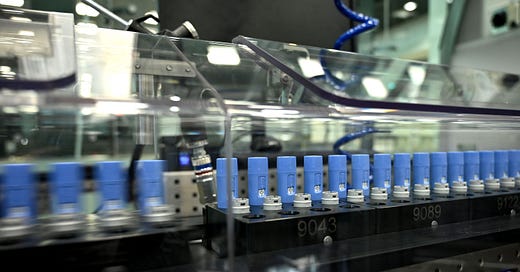
Ozempic Is Obviously Good For Business
This drug is going to have huge benefits for health, well-being and the economy. Why the weird fixation on ways it could reduce corporate profits?
Dear readers,
There’s an Amy Schumer bit where she says, “I have never said, ‘Oh my god, I forgot to have lunch today!’ Like, never in my life. If anything, I’ve been like, ‘Oh shit, I had two lunches today.’”
I relate deeply to this — I never forget to eat. In fact, it feels like there’s a voice constantly mumbling in the back of my head “eat eat eat” — and all the efforts in my life to keep off excess weight have involved fighting that voice. When I have won that fight, it’s been through constant vigilance — in its most effective form, meticulous calorie counting combined with consistent self-denial. This weight-loss approach uses up a lot of mental bandwidth, and it’s no coincidence that I reached my lowest adult weight during my least demanding adult job (at Bloomberg News) and that I gained between 15 and 20 pounds in my first year putting out this newsletter.
As you might expect, I’ve been following with interest the news about the new, highly effective class of weight loss drugs that’s on the market. The more I read, and the more I spoke with people who have taken them, the more I’ve been interested in going on one of them. And three and a half weeks ago, I started taking Wegovy, the weight-loss drug from Novo Nordisk that contains semaglutide, the same active ingredient as Ozempic.1
Semaglutide works by mimicking the hormone GLP-1, which has digestion-related effects on multiple organs. It slows the emptying of the stomach, and so discourages eating by making you feel more full. In the pancreas, it encourages production of insulin; I’m not diabetic, but this is why it’s also used to treat diabetes. And it sends a message of satiety to the brain — essentially, it turns off the “eat eat eat” voice.
I’ve lost five pounds already. The weight loss didn’t surprise me; what has surprised me is that losing this weight has been easy so far, and I haven’t needed to count anything. I just eat less. I haven’t forgotten to eat lunch, as such, but on a couple of days I have chosen not to. One day, I went to a cafeteria where none of the options looked very good, so I just had a cup of tomato soup. Another day, all I had for lunch was a banana. These aren’t choices I would have made previously, and if I had, I would have spent the afternoon miserable and hungry in the aftermath. But I wasn’t.
I’m experiencing for the first time what it must be like to be a thin person. I don’t mean thinness itself (I got some experience with that in 2013) but the set of feelings and motivations and urges — or, more importantly, the lack thereof — that must have been causing persistent and (at least apparently) low-effort thinness in all these other people all this time. The drug is turning me into the sort of person who might forget to eat lunch. It’s already changed my perspective on how other people experience the world — for one small thing, I’ve rethought my cynicism about food influencers with six-pack abs. And this change has come despite the fact that I am just on the starter dose of 0.25 mg per week. Experiences seem to vary, with some people experiencing changes in appetite and weight from the jump (as I have) and others reporting they don’t start to lose weight until escalating to a much-higher maintenance dose like 1.7 mg.
These drugs are going to be enormously beneficial for the economy, society and public health
Back in June, I tweeted that “10 years from now, it’ll be obvious GLP-1 drugs were a way bigger deal than AI.” Some people wrote to me asking me to elaborate on that, but I didn’t really want to say more until I had actually gone on one of the drugs — and at the time, I was still working on the frustrating process of obtaining them.
But my basic view is that more than half the population ought to be on these drugs and probably will be within a decade or two. Those people will generally lose 15% or more of their body weight — probably more, given that similar drugs in development appear to be even more effective than the ones already on the market — and will keep it off so long as they stay on the drugs, which may well need to be indefinitely. All that weight loss will improve health outcomes in obvious ways like reducing cardiovascular disease and diabetes, and in less obvious ways like fewer people needing knee replacements or kidney dialysis. Lower disease burden will mean fewer sick days and higher labor productivity. And there will be huge gains in personal happiness: well over a hundred million Americans who have been struggling all their lives to control their weight will be finally succeeding at it, and in a way that does not involve a great deal of mental effort or perceived sacrifice. People will gain self-esteem, they’ll be relieved of negative feelings about their weight, and they’ll be able to redirect (often substantial) energy they once devoted to dieting to other endeavors.
And that’s just considering the drugs’ intended effects on weight (and diabetes). There’s also the matter of other improvements in impulse control — how these drugs seem to have the positive side effect of helping at least some people control substance use, gambling, compulsive shopping, and other problem behaviors. We may have stumbled upon a drug class that broadly improves people’s judgment and decision-making. Isn’t that amazing?

As such, I’m baffled by the recent boomlet in business coverage that focuses on how widespread adoption of GLP-1 could be bad for various kinds of business. Matt Levine had a roundup of this coverage on Monday under the headline “Ozempic is bad for business,” and I will grant that certain specific firms like PepsiCo may lose money if Americans start consuming a lot fewer calories. (Another example: DaVita, an operator of dialysis clinics, has been battered in the stock market recently due to “concern” that Ozempic is significantly improving diabetic patients’ kidney health.) It makes sense that analysts on corporate earnings calls are asking questions about how this big societal change might affect earnings at one company or another, and that these discussions are getting written up in the business press. But Matt goes further and suggests that widespread adoption of these drugs is likely to reduce overall corporate profits by stifling demand:
[I]magine a pharmaceutical company that has invented… a drug that reduces consumption in general, a universal demand suppressant. It makes the people who take it so much happier and more fulfilled that they don’t want anything else. They eat less food and drink less alcohol and buy fewer clothes and take fewer vacations and get fewer haircuts and consume less social media and click on fewer online ads and otherwise consume much less.
If you were the chief executive officer of a publicly traded pharmaceutical company and your researchers invented that drug, what would you think? On the one hand, you could probably sell it for a lot of money and have big profits. On the other hand, it’s going to be really bad for all the other companies, the ones selling food and alcohol and vacations and online ads. And the shareholders who own your company also own those companies. Probably more of them. Your profits come at the expense of the rest of your owners’ portfolio. By making money for them in your business, you are making them worse off overall…
I am not a scientist but I feel like some of what I read about these drugs suggest that they are almost universal demand suppressants, or at least that they are good at suppressing a lot of addictive behavior. Snacking, drinking, smoking, but what about scrolling Instagram or clicking online ads? Sure it starts with Slim Jims, but does it end there?
It is theoretically possible that a major positive social and public health change could lead to reduced economic output — American consumers could take all their savings from eating less and drinking less and making fewer impulsive shopping decisions, and put them toward a reduction in work hours and earlier retirement — but that is not usually how these things work.
Consider an area where we’ve had a lot of success fighting addiction over the last few decades: reduced smoking rates. You could tell a story where reduced spending on cigarettes depresses corporate profits and GDP — that ex-smokers spend less, and this allows them to work less and retire earlier. But that seems obviously wrong — ex-smokers work more than still-smokers because they are less burdened by disease and disability. What are those ex-smokers doing with the proceeds of their greater productivity? Presumably, they’re taking their earnings and spending more than they otherwise would have on non-cigarette products and services. And even if their financial gains from not smoking are going into savings instead of consumption, that is still fueling economic activity — a positive shock to the savings rate pushes interest rates down and makes it easier for businesses to invest and individuals to consume, even if those individuals never smoked.
I think the economic effects of widespread adoption of GLP-1 drugs are likely to look like this: You’ll get positive supply-side effects from improvements to population health and worker productivity,2 and on the demand side, you’ll get shifts away from specific products and services whose consumption is inhibited by the drugs (food, alcohol, gambling, certain medical treatments) which will then lead to a rise in demand for other products and services as consumers find they have more money available to spend on them. As such, any industry that does not have a specific story about why GLP-1 drugs will reduce demand should be thought of as an industry where they will increase demand. And even for some directly impacted industries, it’s plausible that positive effects on the supply side will more than offset the negative effects on the demand side.
There is also the issue of the drugs’ high cost. Unless you are diabetic, it is currently difficult to get insurance coverage for them, and they cost about $1,000 a month after rebates. In the short term, this is a significant problem both for consumers and for the employers who fund the health insurance plans that do sometimes pick up the tab. But in the medium term, manufacturing capacity for the drugs will grow to meet demand, and similar competing drugs from multiple manufacturers are likely to come on the market. This will create a situation where manufacturers must compete on price well before any of their patents expire — that is, prices should come down, a lot.
People aren’t thinking big enough about this
I’m an unusual person on various dimensions, but my difficulty managing my weight is one of the most ordinary things about me. Being overweight, wanting to weigh less, and finding it really hard to succeed at that is one of the most common problems that exists out there — one that lots of people devote a tremendous amount of time, money, and energy toward, and one that lots of people feel quite bad about their failure to address. And this technological advance has put us on the cusp of making it much, much easier for massive numbers of people to address this problem with ease.
Quite possibly, the advance is even broader than that — it may go a long way to address the general problem of people making short-term choices that foreseeably fail to promote their long-term happiness. Isn’t that amazing?
This is why I make the comparison to the AI mania. AI is interesting technology that already has some uses — I’ve been using it to illustrate this newsletter — and that may prove increasingly helpful as we try to come up with ways to solve problems in the future. But these drugs are demonstrably a solution to a huge problem that exists right now — effectively, they improve humans’ natural intelligence along at least one dimension and probably several. I think that’s extremely exciting and a much better candidate for singularly-important-technological-advance-of-our-time than AI.
Obviously, we have a lot to learn about how these drugs will be applied — societally, and to me, personally. I’ll keep you posted about how I’m feeling and how much weight I’m losing as my dosage steps up; I am mindful that some people have side effects that make the drugs unsustainable, though so far I haven’t had any issues. But my expectation is that I will continue to think that, despite all the news coverage, these drugs actually are getting less hype than they deserve.
Very seriously,
Josh
Ozempic is officially a diabetes treatment, while Wegovy has been approved by the FDA for weight loss. Both are injectable drugs made by Novo Nordisk and both are semaglutide, but they come in different dosages and are dispensed differently. In practice, both are often being used for weight loss, and the public shorthand for both products seems to be “Ozempic,” perhaps because it came to market first.
Besides the indirect channel toward improved productivity that runs through improved health, I’d also consider the possibility that the improved impulse control afforded by GLP-1 drugs will directly improve job performance. Personally, I find the drugs are making it easier for me to write on an empty stomach.















Josh, super excited to read this piece. I’ve been taking Wegovy since April and have gone from 203 lbs to 146 lbs with minimal side effects. This drug has truly been a miracle for me - my confidence is way up, I have more energy, I look and feel better - and all of this directly contributes to my performance at work.
An unexpected effect was the impact it had on my drinking. I went from drinking a bottle a night (!) to maybe a glass a week - what a massive difference not just in my pocketbook but also to my mental health.
I’m right there with you - this drug is a game-changer. You’ll have to pry it from my cold, dead hands. Looking forward to following your journey!
The Pill. That’s what came to mind when I read this. I’m neither a doctor nor a sociologist but it’s seems The Pill was a similarly transformative drug. It changed the destiny of so many women, by easily controlling that which had previously been very challenging to control. That’s what it sounds like when I read your description of semiglutides.
And what did women do with their reproductive freedom? They worked! More of them got jobs, and more of them stayed on the job for longer.
Obviously this will look different with semiglutides in some way (again, neither a doctor nor a sociologist) but it establishes how a single pill unlocked extraordinary economic activity in the not-too-distant past.